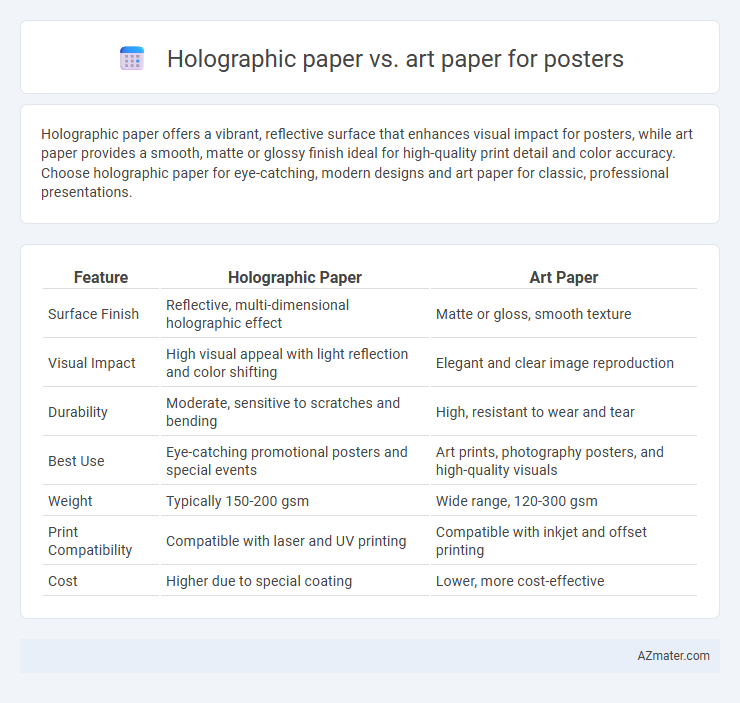Holographic paper offers a vibrant, reflective surface that enhances visual impact for posters, while art paper provides a smooth, matte or glossy finish ideal for high-quality print detail and color accuracy. Choose holographic paper for eye-catching, modern designs and art paper for classic, professional presentations.
Table of Comparison
| Feature | Holographic Paper | Art Paper |
|---|---|---|
| Surface Finish | Reflective, multi-dimensional holographic effect | Matte or gloss, smooth texture |
| Visual Impact | High visual appeal with light reflection and color shifting | Elegant and clear image reproduction |
| Durability | Moderate, sensitive to scratches and bending | High, resistant to wear and tear |
| Best Use | Eye-catching promotional posters and special events | Art prints, photography posters, and high-quality visuals |
| Weight | Typically 150-200 gsm | Wide range, 120-300 gsm |
| Print Compatibility | Compatible with laser and UV printing | Compatible with inkjet and offset printing |
| Cost | Higher due to special coating | Lower, more cost-effective |
Introduction: Holographic Paper vs Art Paper for Posters
Holographic paper offers vibrant, reflective surfaces that enhance poster visibility through dynamic light interaction, making it ideal for promotional and eye-catching designs. Art paper, known for its smooth texture and excellent ink absorption, provides superior color accuracy and detail reproduction, suitable for fine art prints and exhibition-quality posters. Choosing between holographic and art paper depends on the desired visual effect and the context in which the poster will be displayed.
Visual Appeal: Shine and Color Dynamics
Holographic paper enhances visual appeal through its reflective surface, creating dynamic shine and vibrant color shifts that captivate viewers from multiple angles. Art paper offers a matte or glossy finish with rich, true-to-life colors but lacks the iridescent shimmer of holographic options. For posters seeking eye-catching brilliance and color play, holographic paper delivers a striking, futuristic aesthetic unmatched by traditional art paper.
Texture and Finish Comparison
Holographic paper features a reflective, iridescent texture that creates dynamic light effects, making posters visually striking with a glossy, shimmering finish. Art paper offers a smooth or subtly textured surface, providing a matte or semi-gloss finish ideal for detailed, high-resolution prints with vivid color accuracy. The choice between holographic and art paper for posters depends on whether bold, eye-catching visuals or refined, fine art replication is desired.
Print Quality and Image Clarity
Holographic paper enhances posters with vibrant, dynamic light reflections that amplify visual appeal but may slightly reduce image sharpness due to its textured surface. Art paper offers superior print quality and image clarity, providing smooth, detailed, and accurate color reproduction ideal for intricate designs. Choosing between the two depends on whether the priority is dazzling effects or precise, high-resolution imagery.
Durability and Longevity of Posters
Holographic paper offers enhanced durability with a protective glossy finish that resists fading, water damage, and scratches, making it ideal for long-lasting posters in vibrant environments. Art paper, typically made from high-quality cotton or wood fibers, provides excellent color reproduction but is more susceptible to wear and tear, moisture, and UV damage over time. For posters requiring extended longevity, especially in high-traffic or outdoor areas, holographic paper outperforms art paper by maintaining visual appeal and structural integrity.
Cost Analysis: Holographic vs Art Paper
Holographic paper for posters typically incurs higher costs due to specialized manufacturing processes and premium materials, often ranging from 30% to 50% above standard art paper prices. Art paper offers a more budget-friendly option, available in various weights and finishes, making it ideal for large print runs without significantly compromising quality. When analyzing cost efficiency, art paper provides substantial savings for bulk orders, while holographic paper adds value through enhanced visual impact at a premium price point.
Suitability for Different Poster Purposes
Holographic paper offers vibrant, reflective effects that enhance promotional and event posters by capturing attention and creating a dynamic visual impact. Art paper, with its smooth texture and superior color reproduction, is ideal for fine art prints and photographic posters requiring high detail and color accuracy. Choosing between holographic and art paper depends on whether the poster's purpose emphasizes visual attraction or detailed imagery.
Compatibility with Printing Techniques
Holographic paper is compatible with laser and inkjet printing, delivering vibrant, reflective effects ideal for eye-catching posters. Art paper, particularly matte or gloss variants, supports a wider range of printing techniques including offset, digital, and screen printing, ensuring detailed and color-accurate visuals. Choosing between holographic and art paper depends on the desired finish and the specific printing technology used for the poster production.
Eco-Friendliness and Sustainability
Holographic paper often contains synthetic materials and metallic coatings that hinder its recyclability and increase environmental impact compared to art paper, which is typically made from natural fibers and more easily biodegradable. Art paper sourced from sustainably managed forests or recycled content demonstrates superior eco-friendliness by reducing deforestation and minimizing landfill waste. Choosing art paper for posters supports sustainable practices by facilitating recycling processes and lowering carbon footprints associated with paper production and disposal.
Conclusion: Choosing the Right Paper for Your Poster
Selecting the right paper for your poster involves balancing visual impact and durability; holographic paper offers a striking reflective finish that enhances color vibrancy and catches attention in dynamic lighting, making it ideal for promotional displays. Art paper provides a smooth, matte or glossy surface that produces sharp, high-resolution images with accurate color reproduction, suitable for fine art prints and professional presentations. Consider the intended display environment and audience engagement to determine whether the eye-catching brilliance of holographic paper or the refined elegance of art paper best suits your poster's purpose.

Infographic: Holographic paper vs Art paper for Poster
 azmater.com
azmater.com